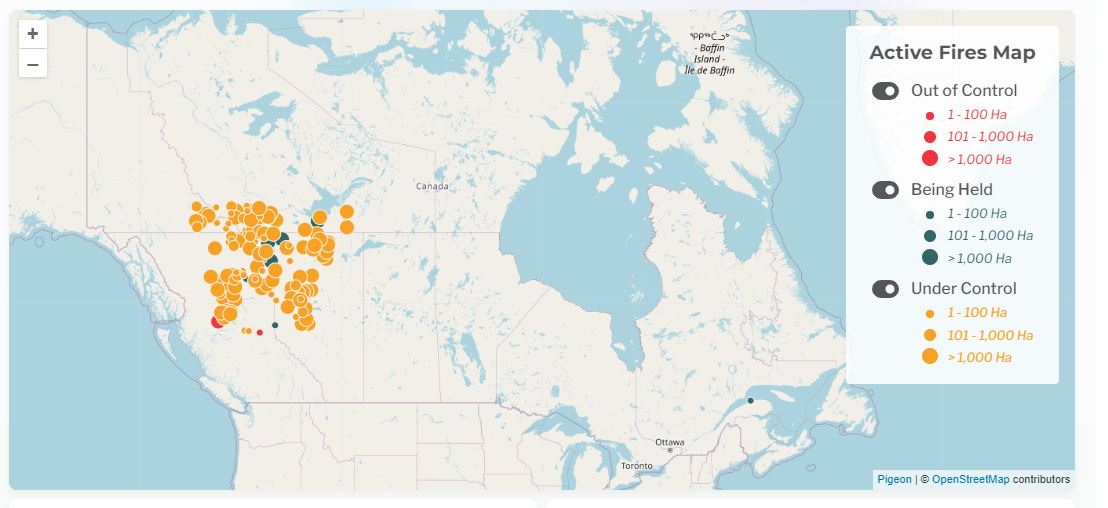The fires of public opinion could be burning like zombie fires boiling underground, according to tantalizing new research.
It takes a real act of will to remember that time, not long ago, when politicians ran to the front of the parade, eager to fall in line with the millions of climate protesters converging on city centers around the world. The pandemic sucked oxygen from those flames and the subsequent economic difficulties have kept them extinguished. But the desire to act may simply be overwintering.
There seems to be a truly surprising level of desire to act on the climate, just below the surface and in every corner of the world. It’s largely dormant because most of us think we’re alone in our anxiety: we’re “conditional cooperators” waiting for it to kick in, according to people who track this sort of thing. Tragically, the real fires of climate change are not so wavering.
In this week’s newsletter we’ll look at the metaphorical fires of public sentiment, as well as the zombie fires burning underground. We’d better start with the ones closest to the eruption.
The Alberta government has already declared the official start of fire season. There are more than 50 fires in the province, most of them zombie fires that refused to be extinguished after the infernos of 2023.
The provincial government is hesitant to utter the words “climate change,” but it is clearly frightened by the information it is receiving from officials: large swathes of Alberta are dry and suffering from severe or extreme droughts.
And wildfire smoke is already a problem for residents of Fort Nelson, BC. In that province there are 92 latent fires. This is in stark contrast to any previous winter. Zombie fires used to be a strange curiosity. More recently, 15 would have been the average. This year is “mind-blowing…just unheard of,” says one forestry scientist.
What people are reading

The fire map of Western Canada is striking: the orange dots are the hibernating zombies, only fires coded red are considered “out of control.” But I’m sure many of you will have the same reaction as me: “It’s only February!”
There are more than 50 fires in Alberta, most of them zombie fires that refused to be extinguished after the infernos of 2023, writes Chris Hatch @zerocarbon #wildfires #ActOnClimate #climate #energy #renewables #GreenNewDeal #cdnpoli

Most zombie fires go unnoticed during the winter. But around Fort Nelson, there have been clouds of smoke rising from the ground within a 40 kilometer radius of the city. Even the snowstorms have been ominous: not so much blackouts as blue-gray blizzards.
“I’ve never experienced a blizzard that smelled like smoke,” said Sonja Leverkus, a firefighter and scientist. said the BBC.
Our tactical maps show zombies are concentrated in western Canada, but this strange winter has other Canadians anxious too. Noah Freedman, a wildland firefighter team leader and vice-president of Ontario Public Service Employees Union Local 703, sounded the alarm this week. writing in Canadian National ObserverFreedman says the provincial government is on a campaign to silence firefighters’ warnings.
“As Ontario’s vast forests become more volatile, its wildfire program becomes increasingly fragile due to a series of crises that the government has been ignoring for years,” Freedman says.
We cannot know what a specific year will bring. But the indicators are ominous. Snow cover is low, drought is widespread and Environment and Climate Change Canada projects abnormally high temperatures nationwide this spring and summer.
I have linked John Vaillant’s extraordinary book. fire weather before. It couldn’t have been more timely when it was published in May of last year and it appears to be equally timely in February 2024. If you haven’t read it yet, there may still be time before zombies emerge on the landscape. As Vaillant writes: “In our future there is a potentially winterless scenario in which fire weather is the only weather and ‘fire season’ never ends.”
burning desire
Let’s move on to the kind of outburst that would be welcome: What if I told you that 89 percent of people around the world think their government should do more to fight global warming? And more than two-thirds say they would be willing to contribute one percent of their income to this task?
Skeptical? It certainly was. But there are powerful ideas in the world survey who found those results: we are deeply social creatures and our public expressions are shaped by the norms and our perceptions of those around us. Those perceptions are very wrong, the study found. People around the world seriously underestimate the commitment that others are willing to make.
And the researchers are focusing on a second idea: We may have good intentions, but we’re not prepared to be stupid. That’s not their language. In the research team’s fancier terminology, humans are “conditional cooperators.” We will move forward if we believe others will too. But for the moment, most of us “systematically underestimate the will of our fellow citizens to act.”
The research was published this month in Nature Climate Change based on a Gallup poll, which surveyed nearly 130,000 people in 125 countries. When it comes to acting against climate pollution, “The world is in a state of pluralistic ignorance.”conclude the authors. “People systematically misperceive the beliefs or attitudes of others.”
In 114 of 125 countries, the majority is willing to contribute. But in 110 of them, that majority mistakenly thinks they are a minority.
So if the results don’t match your own daily experience in the city, it could be that there’s more desire for action burning beneath the surface than people are willing to express.
It could also be that you live in a country like Canada. One of the heartbreaking results of the research is that people are more willing to come forward in poorer countries (and less dominated by the promotion of fossil fuels).
The lighter the color of the map below, the stingier it will be. One cannot help but notice the correlation with the places where fossil fuel propagandists have had the most involvement.
Figure 1: Widespread global support for climate action. De Andre, P et al. Nat. Upload. Chang. (2024)
Whatever the color and no matter where a country falls on the list, there is still a strong latent desire for greater climate action. Their public expression can be destroyed by propaganda and political distortions. But burning beneath the surface, researchers found that 82 per cent of Canadians want intensified political action.
After examining all of those responses and analyzing the obstacles, the team came to a simple but fundamental conclusion:
“Rather than echoing the concerns of a minority who oppose any form of climate action, we must effectively communicate that the vast majority of people around the world are willing to act and expect their national government to act.” .
Chris Hatch writes Canada’s National Observer’s celebrated Sunday newsletter, Zero Carbon (subscribe). Chris is the former executive director of the Rainforest Action Network and former executive editor of Canada’s National Observer.
